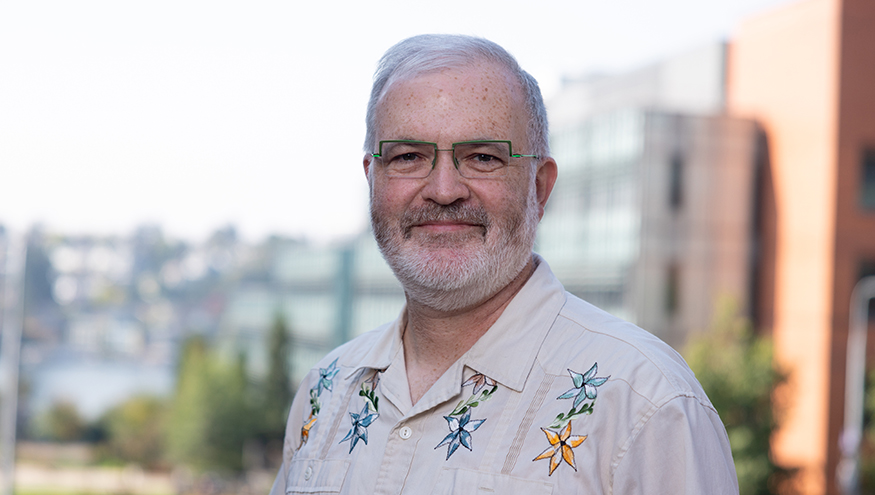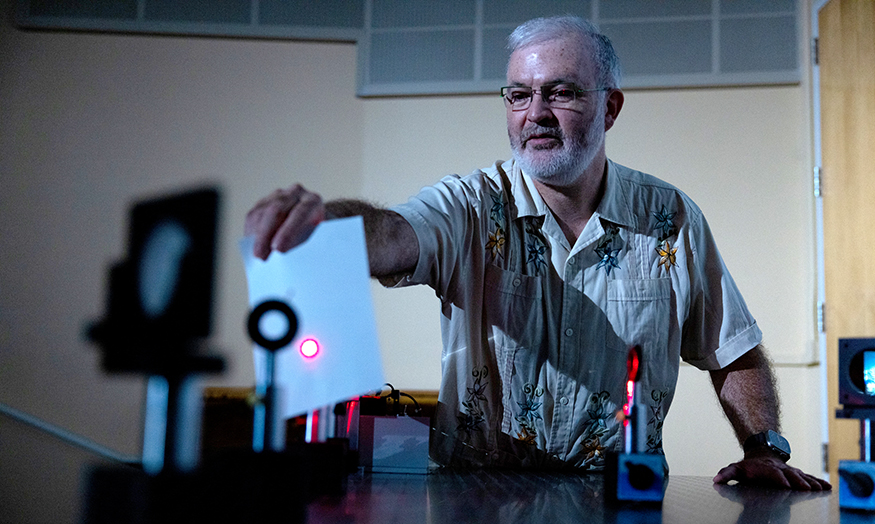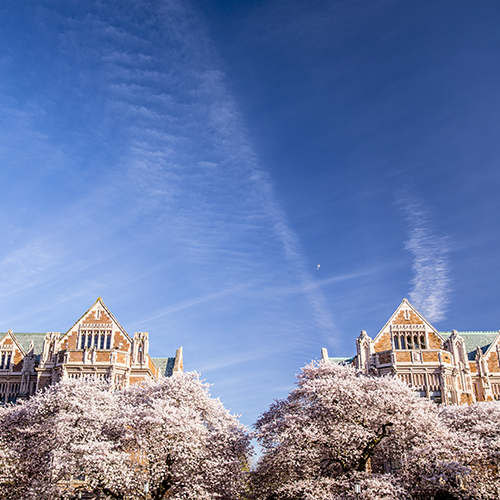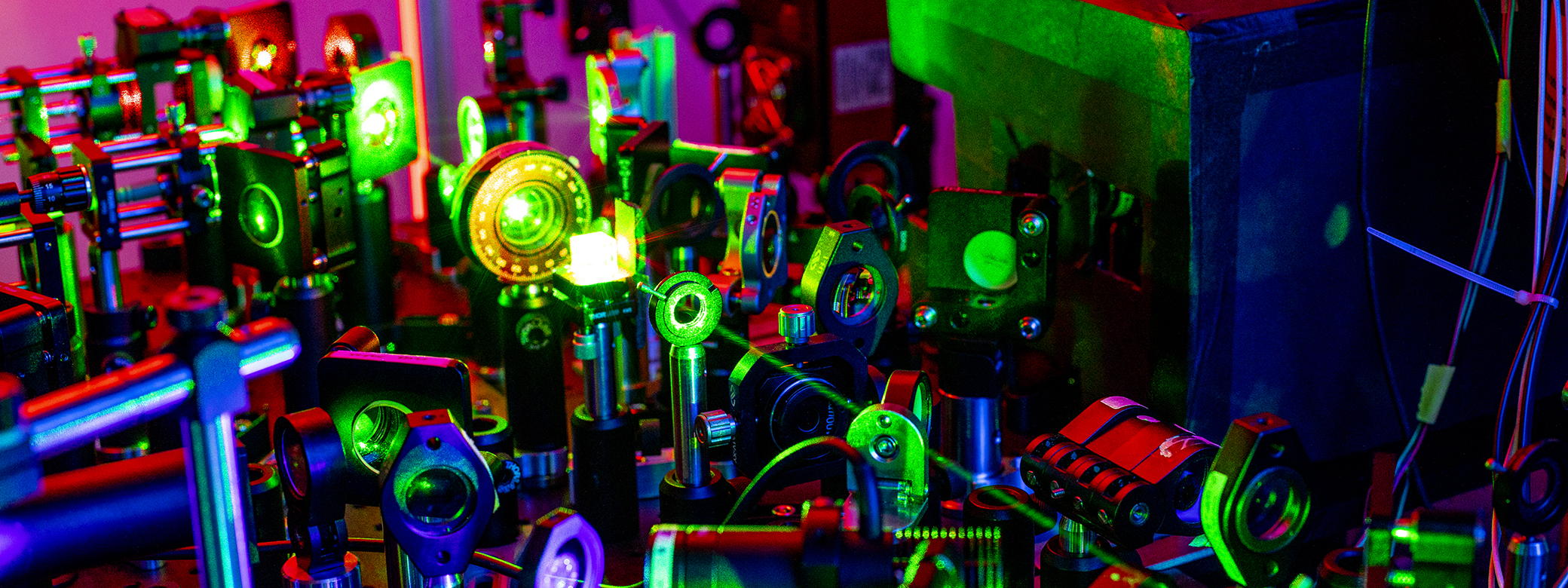
For many people, quantum mechanics seems impossible to grasp. The idea that particles can exist in multiple states simultaneously, or that they can communicate with other particles across vast distances, is far from intuitive. But University of Washington professor Miguel Morales believes that anyone can learn the basics of quantum, even those with no science background. Five years ago, he created a quantum mechanics course for non-STEM students to prove it.
Morales, professor of physics in the UW College of Arts & Sciences, dreamed up the course during his sabbatical. “Somebody gave me the advice to do one thing on my sabbatical that I wouldn’t do normally,” he says. “I’d been teaching a graduate physics course on research methods that included quantum mechanics, and I wondered if some of the examples and experiments in the course could be taught to someone without a math background. I sketched some ideas and wrote a chapter as a challenge to myself.”
That chapter led to a seven-part series, “A curious observer’s guide to quantum mechanics,” first published in Ars Technica. Then, using that as his inspiration and course text, Morales created a physics course for non-STEM students titled “Quantum Mechanics, Relativity, and the Foundations of Our Modern Technological World.” He’s now taught the course five times to students majoring in everything from philosophy to communication to dance.
“Our technology has been undergoing a very quiet revolution,” says Morales. “Now we are seeing things in our everyday lives that require and use quantum mechanics, like quantum-dot TVs and photographic sensors used in digital cameras. And more things will be coming in the next few years. Understanding that, and having some technical literacy, is the goal of this course.”
The How and Why of Quantum
Morales explains that quantum mechanics describes how all the material in the universe works at the fundamental level. “It’s everywhere,” he says. “It’s really a question of how closely you are looking.”
The language of quantum science is mathematics, so teaching it without using math is no small feat. UW physics majors, who study quantum throughout their undergraduate years, take increasingly advanced math courses before they can go deeper into quantum. Creating a course for non-STEM students required identifying concepts that could be taught without math.
Our technology has been undergoing a very quiet revolution. ...Understanding that, and having some technical literacy, is the goal of this course.
Morales identified quite a few. He designed the course so that each topic builds on previous content, guiding students toward more difficult concepts. “Students have done really well in the course, but they’ve had to bring their thinking caps,” he says. “If they miss a week or just aren’t paying attention, things will get really hard really fast.”
The course starts with some scientific history, showing how technological advancements have led to ever more precise ways of measuring and understanding the world around us, including clocks developed for navigation, discoveries of special relativity and electromagnetism, and more recently, advancements in quantum mechanics.
To introduce the central concepts of quantum, Morales explains how particles move like waves but show up as spots when they hit a detector. He then discusses the behavior of trapped waves, using musical instruments as examples of waves trapped to create specific sounds. From there, he explains how atoms are naturally occurring traps for electrons, and how quantum dots — semiconductor beads central to quantum technology — are also traps for electrons. By the end of the quarter, students learn how these concepts translate to current MRI and GPS technology and future technologies in development.

Throughout the course, Morales provides visual demonstrations with lasers and other materials to demystify concepts like waves and traps. He also plans engaging assignments, including a famous wave experiment first performed by scientist and physician Thomas Young in 1801.
“For that assignment, we had to send a laser through a pair of slits and observe the two waves meeting each other on the other side,” recalls David Abramowitz (BA, 2023), who took Morales’s course as a political science major. “To perform the same experiment that Thomas Young had done — except his probably wasn’t done on a pool table as mine was — and see light’s property as a wave for myself was a wonderful learning experience and very fun." More broadly, Abramowitz says, "Professor Morales's course gave me a far greater appreciation for the world around me. It was a highlight of my undergraduate experience.”
More Quantum Courses Coming
With the success of his course for non-STEM students, Morales is now preparing to pilot another new quantum course, this one for STEM students not majoring in physics. He explains that each year up to 3,000 UW students with majors in engineering, chemistry, biology, and other STEM fields take an introductory physics sequence as a requirement for their major. To date, the sequence has not included quantum mechanics because of the heavy mathematical component.
“To be honest, up until now, students in those majors didn’t need to study quantum,” Morales says. “Suddenly they do because of the quantum technology that’s here and that’s coming.”
Morales envisions the new course as being somewhere between the mathematics-heavy content for majors and the course for non-STEM students. The hope is that, in the future, such a course can be an elective option for non-physics STEM students, particularly those majoring in quantum-heavy fields like computer science & engineering.
“As a department, Physics is really pushing to broaden our reach in teaching quantum,” Morales says. “We’re putting resources behind this effort and trying to be a national leader in this work.”
That expansive thinking is important for the department, Morales says, but also for academia more broadly. He sees the UW as a place that understands that.
“So much of what the UW does well is being at the forefront of learning how to teach the newest things to students,” he says. “There’s a lot of work that goes into figuring out how to translate the cutting edge. You need faculty who are researching the cutting edge and learning how to talk about it, and you need a university that fosters opportunities for faculty to explore and try things in the classroom. The UW has both, which makes it an exciting place to be.”
More Stories

A "gesture" to jump-start careers
To prepare students for professional success, the UW College of Arts and Sciences offers “gesture,” a mock startup company where student interns gain skills that employers seek.

Can Machines Learn Morality?
UW researchers at the Institute for Learning & Brain Sciences and in the Allen School are exploring the potential for training AI to value altruism.

Meet Our 2025 Graduate Medalists
Meet the four graduating students selected by the College of Arts & Sciences as 2025 Graduate Medalists for their accomplishments.
